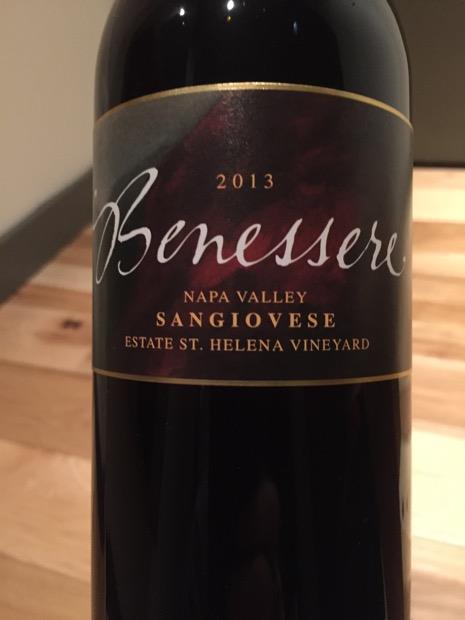
External search
Google (images)
Wine Advocate
Wine Spectator
Burghound
Wine-Searcher
Vintages
2021
2019
2018
2017
2016
2015
2014
2013
2012
2011
2010
2009
2008
2007
2006
2005
2004
2003
2002
2001
Show more
From this producer
Show all wines
All tasting notes
|
| Drinking Windows and Values |
| Drinking window: Drink between 2016 and 2021 (based on 41 user opinions) |
| Community Tasting History |
| Community Tasting Notes (average 90 pts. and median of 90 pts. in 2 notes) - hiding notes with no text | | | Tasted by galencoleman on 2/3/2016 & rated 91 points: Perfect pairing with arrabiata sauce (1084 views) | | | Tasted by 82Latour on 9/28/2015 & rated 89 points: Week in wine country; 9/26/2015-10/3/2015 (Napa Valley): Light pale red, gold on the rim.Spice, oak and black cherry on the nose, strawberry, black cherry on the palate, lingering mid+ finish with a balanced acid. (1867 views) |
| Benessere Producer websiteSangioveseSANGIOVESE: (Pronounced "sahn-joh-vhe-se").
Sangiovese - Italy's claim to fame, the pride of Tuscany. Traditionally made, the wines are full of cherry fruit, earth, and cedar. It produces Chianti (Classico), Rosso di Montalcino, Brunello di Montalcino, Rosso di Montepulciano, Montefalco Rosso, and many others. Sangiovese is also the backbone in many of the acclaimed, modern-styled "Super-Tuscans", where it is blended with Bordeaux varietals (Cabernet Sauvignon, Merlot, and Cabernet Franc) and typically aged in French oak barrels, resulting a wine primed for the international market in the style of a typical California cabernet: oaky, high-alcohol, and a ripe, jammy, fruit-forward profile.[16]
Semi-classic grape grown in the Tuscany region of Italy. Used to produce the Chianti and other Tuscan red wines. Has many clonal versions, two of which seem to predominate. The Sangiovese Grosso clone Brunello variety is used for the dark red, traditionally powerful and slow-maturing "Brunello di Montalcino" wine. The other is the Sangiovese Piccolo, also known under the historical synonym name Sangioveto, used for standard Chianti Classico DOC wines. Old vine derived wine is often used in the better versions, needing several years ageing to reach peak. A third clone, Morellino, is used in a popular wine blend with the same name found in the southern part of the province. Recent efforts in California with clones of this variety are very promising, producing medium-bodied reds with rich cherry or plumlike flavors and aromas. Among the available clonal versions are R6 and R7, derived from the Montalcino region of Italy, having average productivity/ripening and producing small berries on medium size clusters. R10 and R24 are well-recommended. R23, listed as deriving from the Emilia-Romagna region, has good vigor with medium-small clusters with earlier ripening. R102 derives from the Montepulciano region and reported to have average vigor with moderate productivity that results in higher sugar levels and good acidity from medium-small berries on medium-small clusters. Has synonym name of Nielluccio where grown in Corsica.USAAmerican wine has been produced since the 1500s, with the first widespread production beginning in New Mexico in 1628. Today, wine production is undertaken in all fifty states, with California producing 84% of all U.S. wine. The continent of North America is home to several native species of grape, including Vitis labrusca, Vitis riparia, Vitis rotundifolia, and Vitis vulpina, but the wine-making industry is based almost entirely on the cultivation of the European Vitis vinifera, which was introduced by European settlers. With more than 1,100,000 acres (4,500 km2) under vine, the United States is the fourth-largest wine producing country in the world, after Italy, Spain, and France.California2021 vintage: "Unlike almost all other areas of the state, the Russian River Valley had higher than normal crops in 2021, which has made for a wine of greater generosity and fruit forwardness than some of its stablemates." - Morgan Twain-Peterson Napa Valley Napa Valley Wineries and Wine (Napa Valley Vintners)Napa ValleySt. Helena |
|




